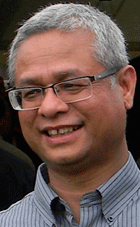Recent News
Ferenchak named chair of Transportation Research Board Pedestrian Committee
October 31, 2025
Ferenchak named APBP 2025 Research Professional of the Year
October 1, 2025
UNM professor to speak at TEDxABQ event
September 24, 2025
NSF funds research to investigate whether treated wastewater can help mitigate water scarcity in arid regions without compromising river ecosystem health
September 2, 2025
News Archives
UNM Engineering Graduate Bijay Rajbhandary Experiences Nepal Earthquake
May 11, 2015
A Nepalese engineer with strong ties to New Mexico on Tuesday described the scene in Kathmandu and the surrounding countryside after Saturday’s earthquake as unimaginable and surreal.
 RAJBHANDARY: Graduated from UNM in 1991
RAJBHANDARY: Graduated from UNM in 1991
“Certain areas look like nothing has passed, while in other areas, towns have been razed to the ground,” University of New Mexico engineering graduate Bijay Rajbhandary said in an email to the Journal.
“We have officially lost over 5,000 fellow citizens, and over 11,000 are injured and 455,000 homeless. These are just the ‘official’ stats – the actual numbers are expected to be far more.”
Many of the victims still must be located and extricated from collapsed buildings, Rajbhandary said.
“Kathmandu may be in bad shape, but the villages (are) worse,” he said.
In addition to the loss of lives and homes, survivors are mourning the destruction of half the country’s historical structures and public squares, Rajbhandary said.
“We also lost the Bhimsen Tower, also known as the Dharahara (an iconic tower in the center of the city) that trapped and killed over a hundred people as it toppled over,” he said.
Rajbhandary, a successful businessman and builder who said his company employs 3,000 people directly and indirectly, may be responsible for saving many lives after the devastating earthquake and avalanches these past few days in his Himalayan nation.
He graduated from UNM in 1991 with a master’s degree in construction engineering and management, a branch of civil engineering he has put to good use in Nepal. After graduation, he remained here for a year, working in construction for Jaynes Corp. to gain experience.
One of the many companies he founded, CE Construction Pvt. Ltd., designed and erected many of the buildings that withstood the magnitude 7.9 earthquake. His works include the Grande International Hospital, where many victims of the disaster have been taken for treatment.
The earthquake revealed the value of engineered buildings and the need for high-quality construction, “a mantra we at CE have been advocating for the last 23 years,” Rajbhandary said.
He was honored with a Distinguished Engineering Award for Young Alumni from UNM’s School of Engineering in 2001.
“Bijay is amazing,” said an old Albuquerque friend of the Rajbhandary family, Kathy Chilton. “He left here in the early ’90s with just his education. That’s all he had.”
Chilton and her husband, Lance, and their two daughters traveled to Nepal in 1985 when Lance Chilton took a temporary position as a substitute doctor with the Peace Corps. It was during their brief stay that Rajbhandary decided to study in New Mexico. The families had known each other for years.
Since then, they have visited each other numerous times, in Nepal and the United States. Two years ago, for example, the Chiltons went to Cornell University in Ithaca, N.Y., where one of Rajbhandary’s two daughters, Yazma, was graduating.
Kathy Chilton said her friend received a great deal of help in getting his business enterprises going from Bill Gross, who was dean of the School of Engineering at UNM.
Gross, who died in 2011, journeyed to Nepal more than once, advising and encouraging Rajbhandary on business and construction ventures.
His widow, Sharon Gross, said she is “personally gripped” by the earthquake.
“Bill’s former student Bijay and his family in Kathmandu (are) close personal friends,” she said in an email to friends. “Bijay credits principles he learned from Bill as guiding the amazing multifaceted construction company and educational institutions he created and leading him into voluntarism. Bijay and his family are safe and the major hospital and many buildings (some very tall) his company has built survived the earthquake.”
Rajbhandary said one of the major problems facing the nation is that the government is not equipped to deal with “this calamity.”
“However, we as Nepali people are quite resilient and do what the government can’t – we rally to help each other out,” he said. “People have opened their door (or rather their lawns if they have any) to their neighbors and strangers. Our country has come together the way Nepalese tend to in times of need.”
People are doing whatever they can to help out, he said, donating blood and clothes when possible.
Rajbhandary said dozens of his construction workers lost their homes and more than 30 of their relatives perished.
“Our first move was to insure they were all fed, had shelter in our job sites and had clean water to drink,” he said.
The company set up committees for food and water supply, shelter, medication and counseling. Staff members plan to clean up the debris from one fallen building every Saturday.
“We believe returning the city to a presentable state shall provide mental relief to many people,” Rajbhandary said.
